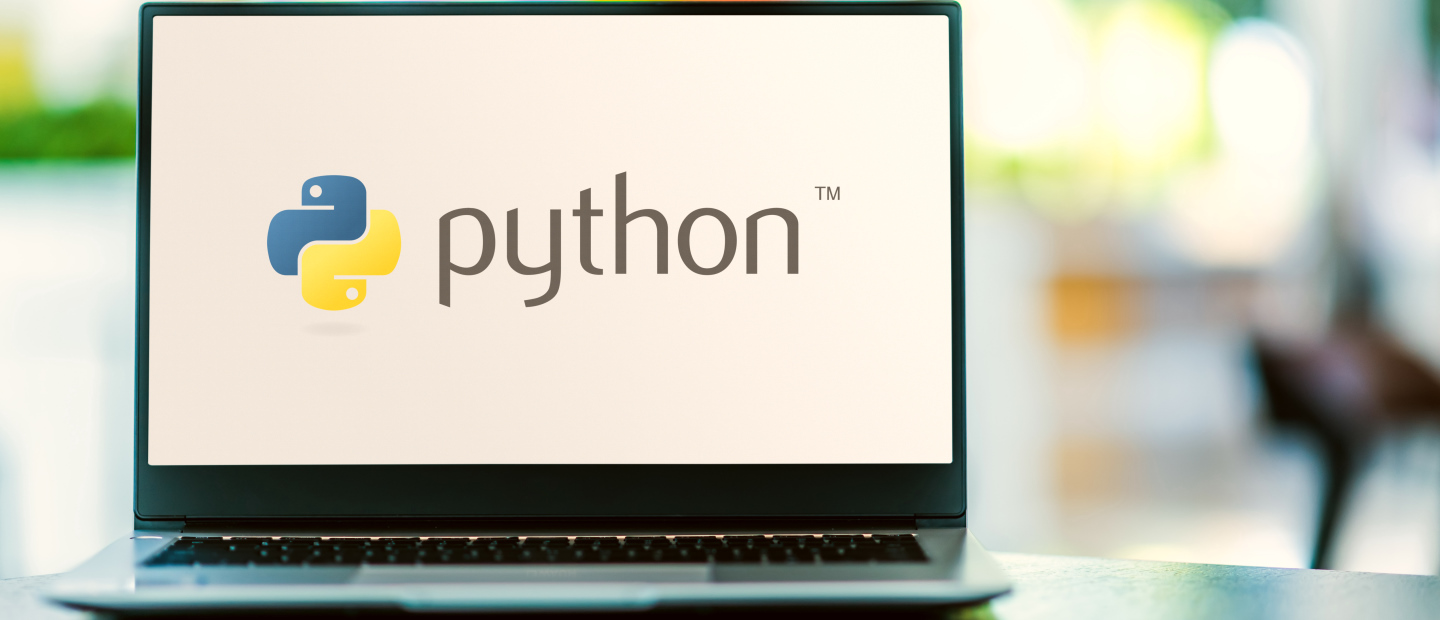10 Best IDEs and Code Editors for Python/Django Development

There is no better way to build in Python than by using an IDE (Integrated Development Environment). They not only make your work much easier as well as logical; they also enhance the coding experience and efficiency.
Sure, everyone knows this. However, the problem is, how do you pick the best environment for development when there are so many options? Is the one Python editor better than others? Such concerns often become an issue that beginner developers face. However, to pick the most suitable one, you need to know what you need it for and what tasks you will work on with it.
In this article, we’ll provide an overview of the best IDEs for Django that are popular among coders and a few other options that are worth considering. But before we delve into it, let’s first explain what a Django/Python IDE means.
What is an IDE for Python, and Why Do You Need It?
An Integrated Development Environment is a software package that developers use to create programs. It’s meant to maximize a programmer’s productivity by incorporating closely related components with simple user interfaces. Essentially, it’s a tool that improves the process of creating, testing, and debugging source code — it makes the job easier. Simply put, you can focus on bigger things, while an IDE takes care of all the routine.
Some of the good Python IDE tools include:
- A text editor
- Compiler and/or interpreter
- Assembly automation tools
- Debugger.
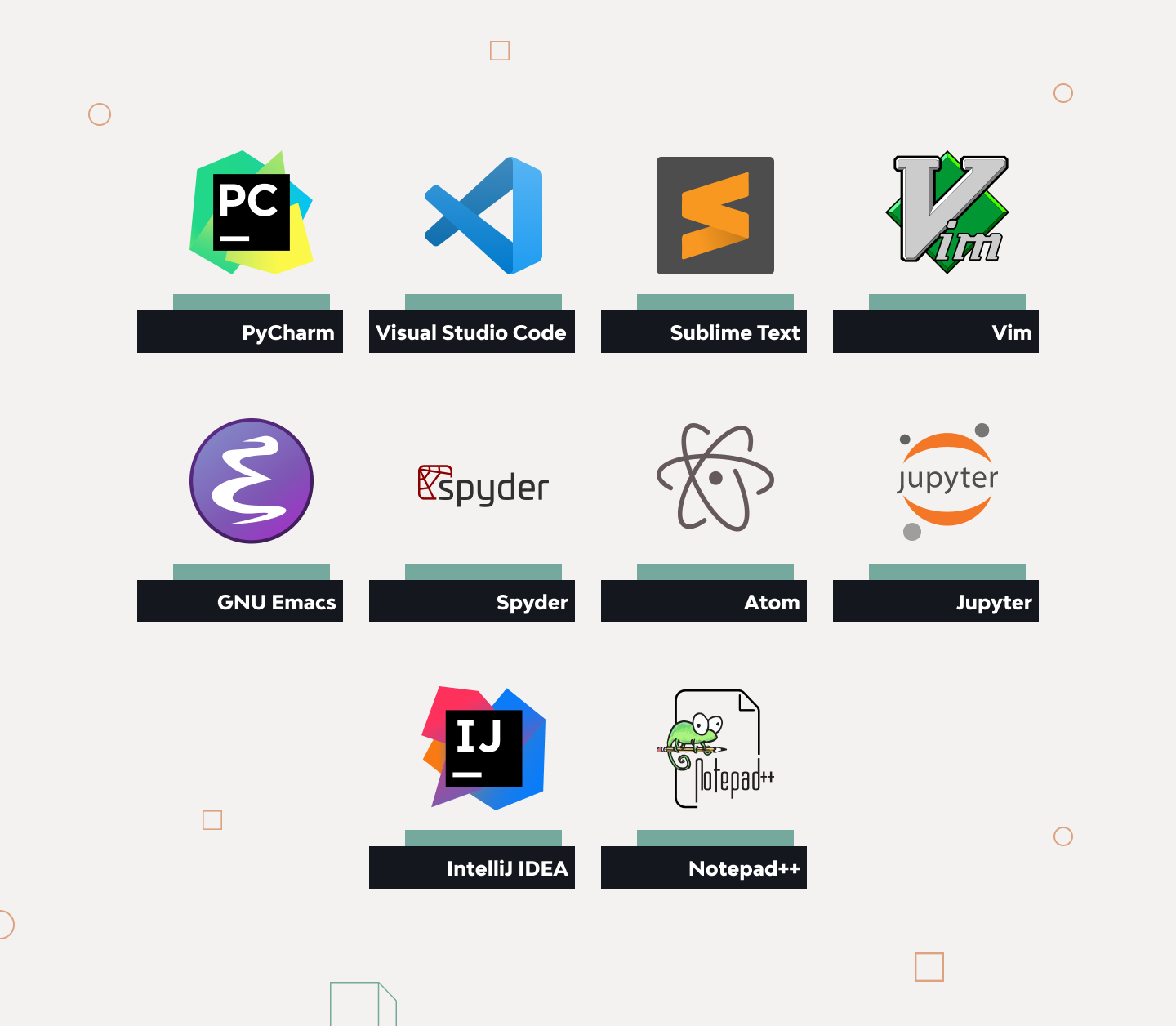
IDE is the main tool for working with a code, which is why choosing the one is so important. It is of great help both for writing and reading code. A developer should choose the best IDE for Django development based on its features and the tasks it’s supposed to perform. The things to pay attention to while looking for the best text editor for Python development are as follows:
- Usability, based on the tasks performed. For instance, code navigation, code color styles, and auto-complete.
- Functions and services support. They depend on the specific project or developer’s needs. For example, one can need a syntax highlight feature for specific languages, while the other seeks a testing system, Django debugger, version control, docker integration, terminal access, etc.
- IDE or Code Editor launch speed. If an IDE is feature-rich yet poorly optimized, it will launch, process, and autocomplete code very slowly, which is a huge shortcoming.
- Ecosystem. It is crucial for an IDE for Python to get its versions updated with new features and bug fixes regularly. The user community matters as well, for it allows communicating with the developers, suggesting feature improvements, and giving them feedback in real time. Even though it is not what all the developers do as users, the product needs to stay up to date and improve continuously, which is nearly impossible with a missing community. Otherwise, you risk facing the limitations of an outdated version, some technology, or an entire language version unsupported.
- Plugin system. Commonly, the basic capacity of an IDE meets over 90% of a developer’s needs. The rest is achieved with the help of third-party plugins.
- Price. There are several options one can take: an open-source IDE, a free version of a proprietary product, a lump sum payment-based, and a subscription. Here, every company or developer makes their own choice in terms of the value of money. Hence, when choosing the best Python IDE for Mac, Windows, or Linux, you will combine the features you expect from it and the budget you have for it.
There’s a seemingly similar term to an integrated development environment — code editor. Let’s first discuss the differences and commonalities of both tools.
What Is a Code Editor?
A code editor is a text editor that highlights the syntax and formats the code. Advanced code editors can develop and modify code.
What features do IDEs and code editors have in common? They enable developers to:
- Store and reopen scripts
- Run their code on it
- Debug
- Highlight syntax.
Read also: 8 Reasons Why Python is Good for AI and ML
Distinctive Features of IDEs and Code Editors
| IDE | Code Editor |
|---|---|
| Provides high-performing libraries or toolkits for advanced coding | Lacks libraries and toolkits |
| Automated | Manual |
| Rich feature collection | Fewer features |
Read also: How to Optimize Python Code Performance
The Most Popular Python IDEs and Code Editors
Now that you have a basic understanding of development tools, including the qualities they possess, we can take a closer look at several favored examples. The Python IDE list we made is based on the JetBrains survey (as the main IDEs and specific ones for web development or data science) and personal experience of our developers.
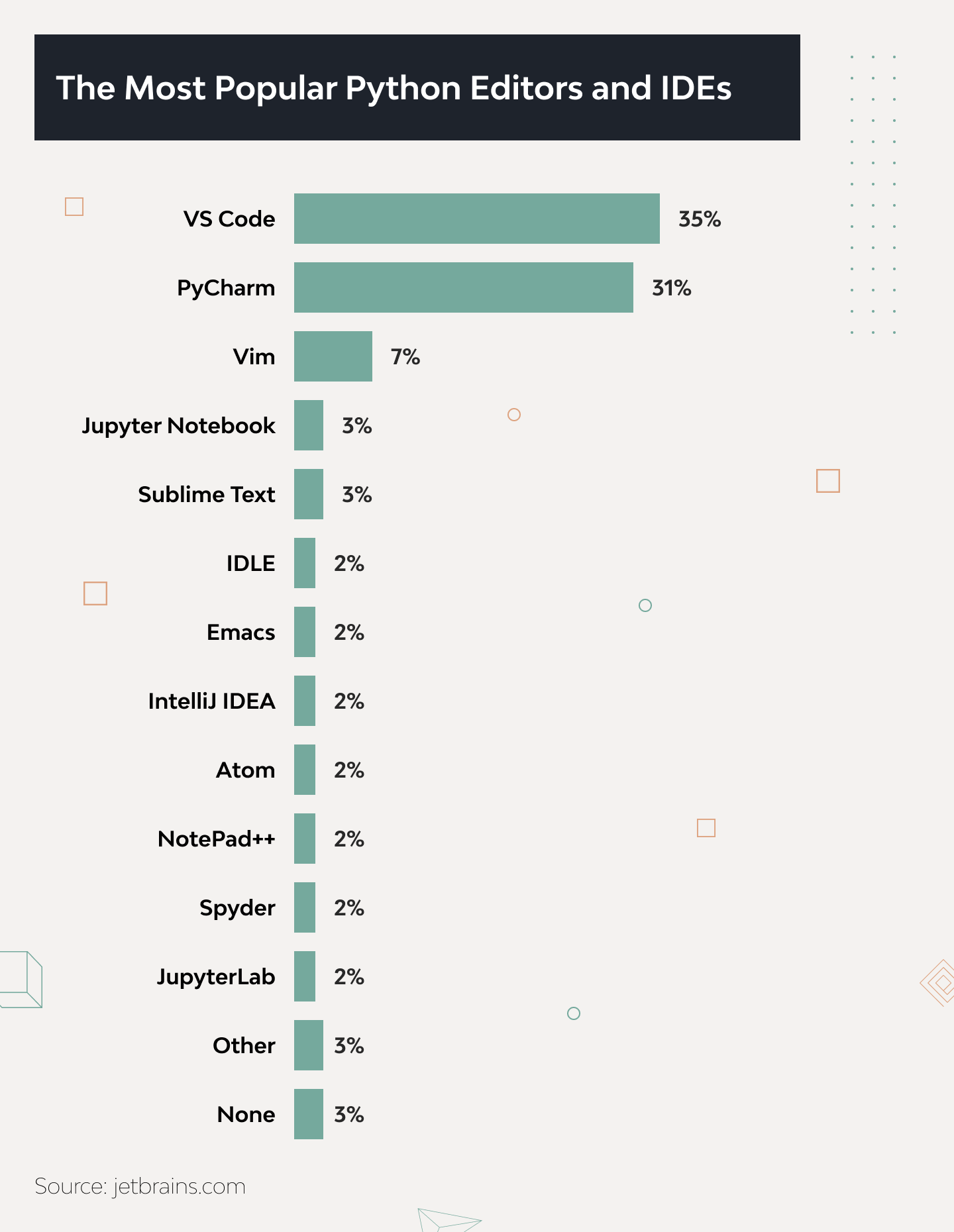
PyCharm
Download link

PyCharm was developed by JetBrains, a notable software development company. It can be considered one of the top contenders for the best Django IDE for Windows, Linux, or Mac. Our engineers refer to it as multi-tool: with it you can do anything on Python – web, desktop applications, scripts, and much more. Most significantly, PyCharm merges its libraries, for example, Matplotlib and NumPy, which enables coders to explore other options for development.
Compatibility: Windows, MacOS, Linux.
Top plugins and features:
- Built-in developer tools
- Capabilities for remote development
- Live editing mode
- IPython Notebook.
Pros:
- PyCharm supports web development frameworks, including Pyramid, Flask, and Django. (Find out why Python is good for web development.)
- Offers a smart code feature for more precise and faster bug fixes.
- Allows to develop on remote hosts thanks to Docker and Vagrant connections and ssh terminal.
Cons:
- The interface might seem bulky.
- The Pro version can seem too expensive.
Visual Studio Code
Download link
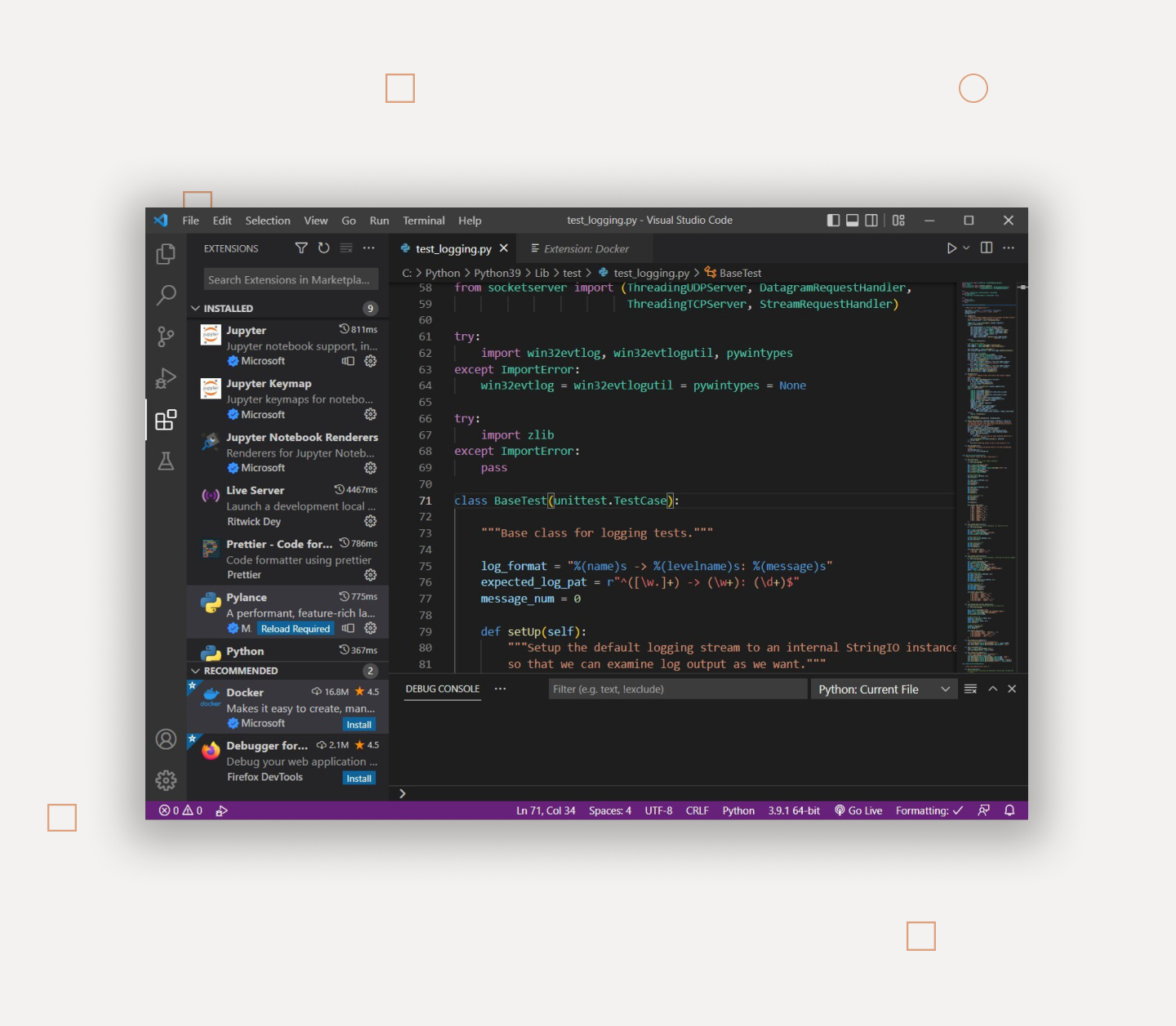
Visual Studio Code is sometimes mistaken for Visual Studio IDE, which isn’t a common tool in the Python world. VS Code is a complete code editor with premium features and many coders say it’s the best IDE for Django out there.
Compatibility: Windows, Linux, Mac OS.
Top plugins and features:
- Built-in git
- Extensions for customizing the tool
- Breakpoints for debugging
- An interactive console.
Pros:
- Its Electron framework allows you to work with VS Code on almost all platforms.
- You can debug the code directly from the editor,
- Supports multiple keyboard shortcuts to speed up coding.
Cons:
- Limited features for debugging.
- Doesn’t have built-in templates.
VI/Vim
Download link
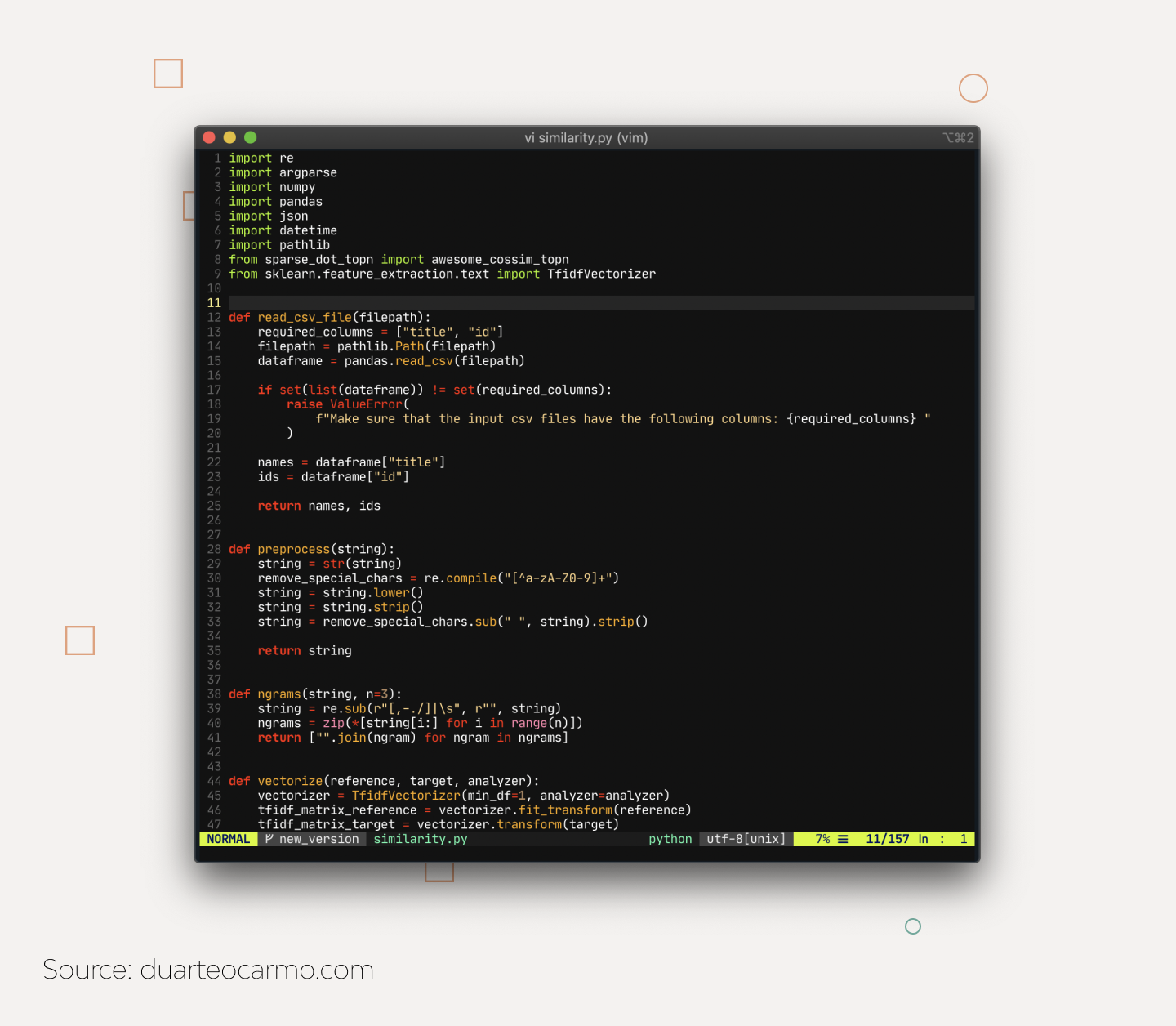
Vim is amongst the top 5 in our list of the best text editors for Python. It is a modal editor that splits file viewing from file editing. It’s a huge step ahead of the initial Vi, with more powerful features.
Compatibility: Windows, Linux, Mac OS, IOS, Android, UNIX, AmigaOS, and MorphOS.
Top plugins and features:
- Scripts that allow you to perform almost all of the programming tasks in Python.
- Ctags for better tag navigation.
- Built-in basic word completion.
Pros:
- It has a keyboard interface to improve efficiency.
- It supports many plugins (e.g., version control, file management).
- Can be extended with different functionality via the .vimrc file (e.g., highlighting search results.
Cons:
- The interface might seem clumsy; some developers find it inconvenient to use.
- Its modal editor may take time for users to learn.
Sublime Text
Download link
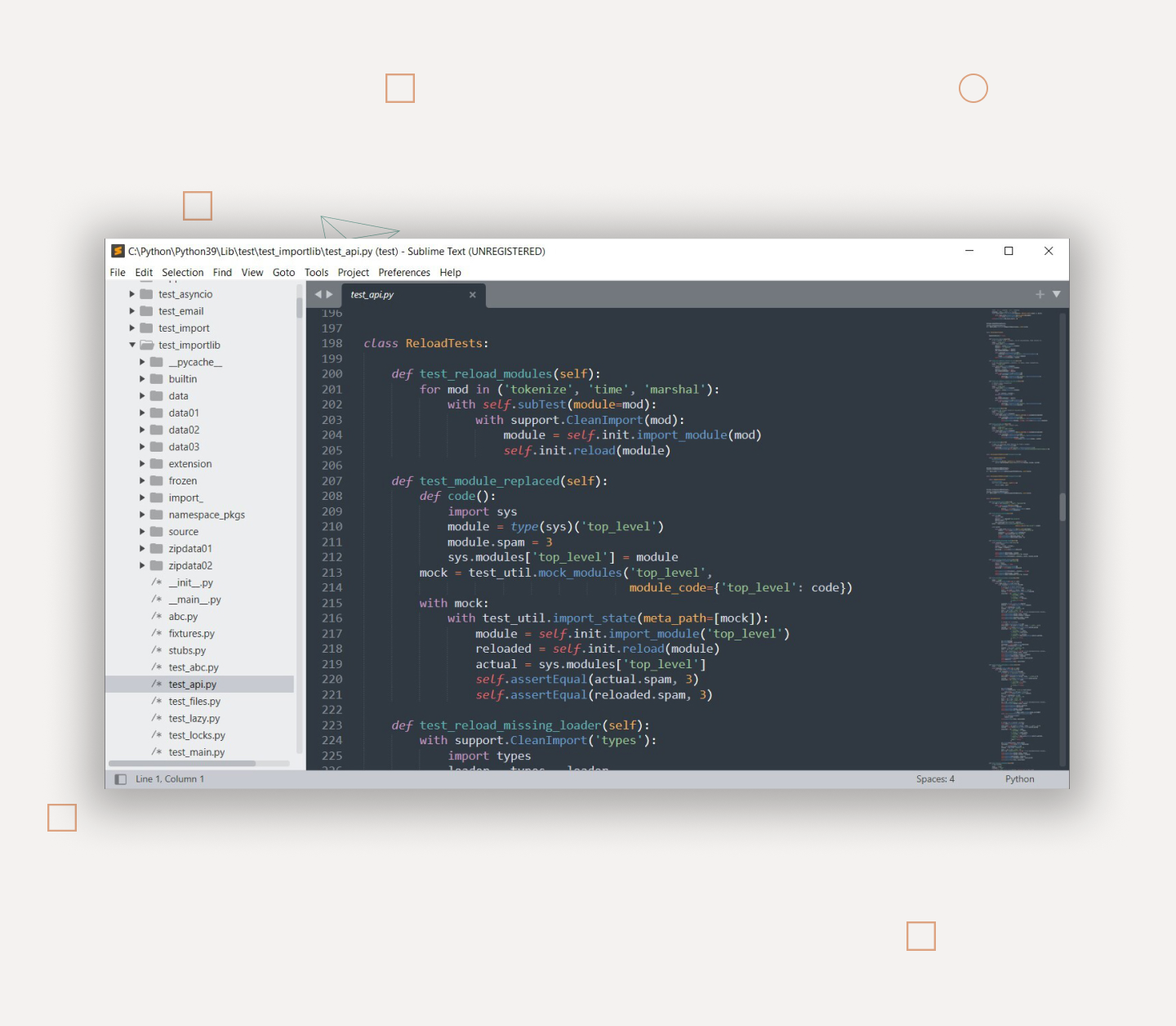
Since we’re not limited to IDEs here, let’s talk about Sublime Text. It can be considered the best one, as it’s universal, convenient, and simple. It’s widely used by most coders, and across different platforms.
Compatibility: Windows, Linux, and Mac OS.
Top plugins and features:
- Easy navigation for high performance
- Support for different packages to customize the editor
- Code snippets for replicating common code with just one keyword
- Immediate project switching and split editing.
Pros:
- Works with different markup languages.
- Enables users to choose which projects they want to work on.
- Comes with a key tool that enables a wide index of classes and functions.
- Provides a strong API and an organized ecosystem for high performance.
Cons:
- A bit advanced for beginners
- Its git plugin isn’t very powerful.
GNU Emacs
Download link
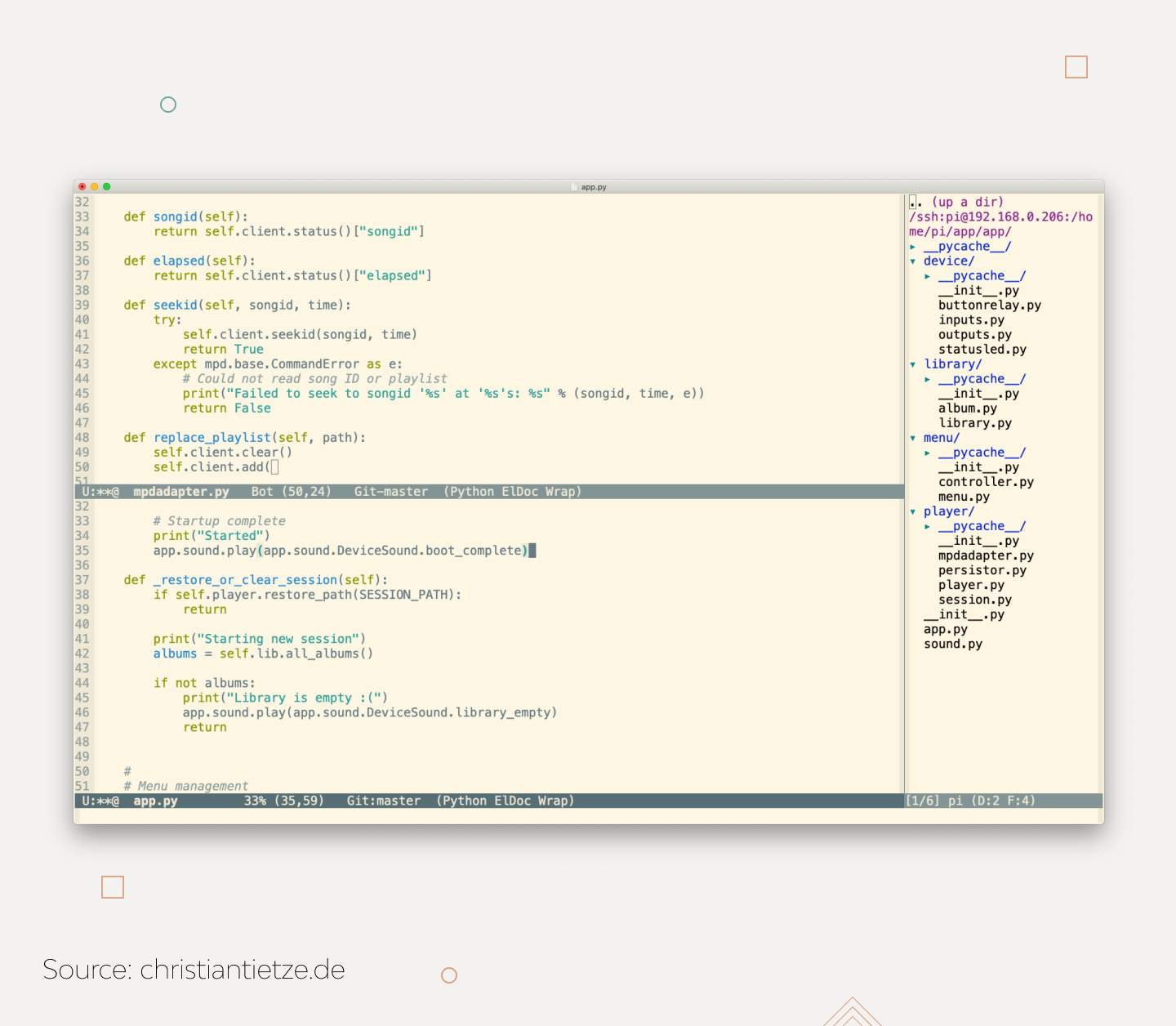
GNU Emacs also competes for the title of the best Python editor. It’s often described as an extendable, self-documenting editor with an on-the-go display. Though not entirely new in the industry, Emacs is constantly upgraded to meet developers’ needs.
Compatibility: Windows, Linux, Mac OS, IOS, Android, UNIX, AmigaOS, and MorphOS.
Top plugins and features:
- Syntax coloring
- Unicode support.
Pros:
- Emacs is compatible with many different platforms.
- It enables a variety of customization scripts that developers can use.
Cons:
- Users might have to spend a little more time learning the editor’s complex customization process.
- It is more complex to use than some of the other IDEs.
The IDE discussed above are also considered the most used Python IDE.
Best Python-compatible IDEs for ML, AI, and BD
Python is one of the go-to languages in machine learning, artificial intelligence, big data, and related fields. The popular Django IDEs below are tailored for and used in classical data science, so we’d like to dedicate a separate section to IDEs that are suitable for Python developers in these areas.
Spyder
Download link
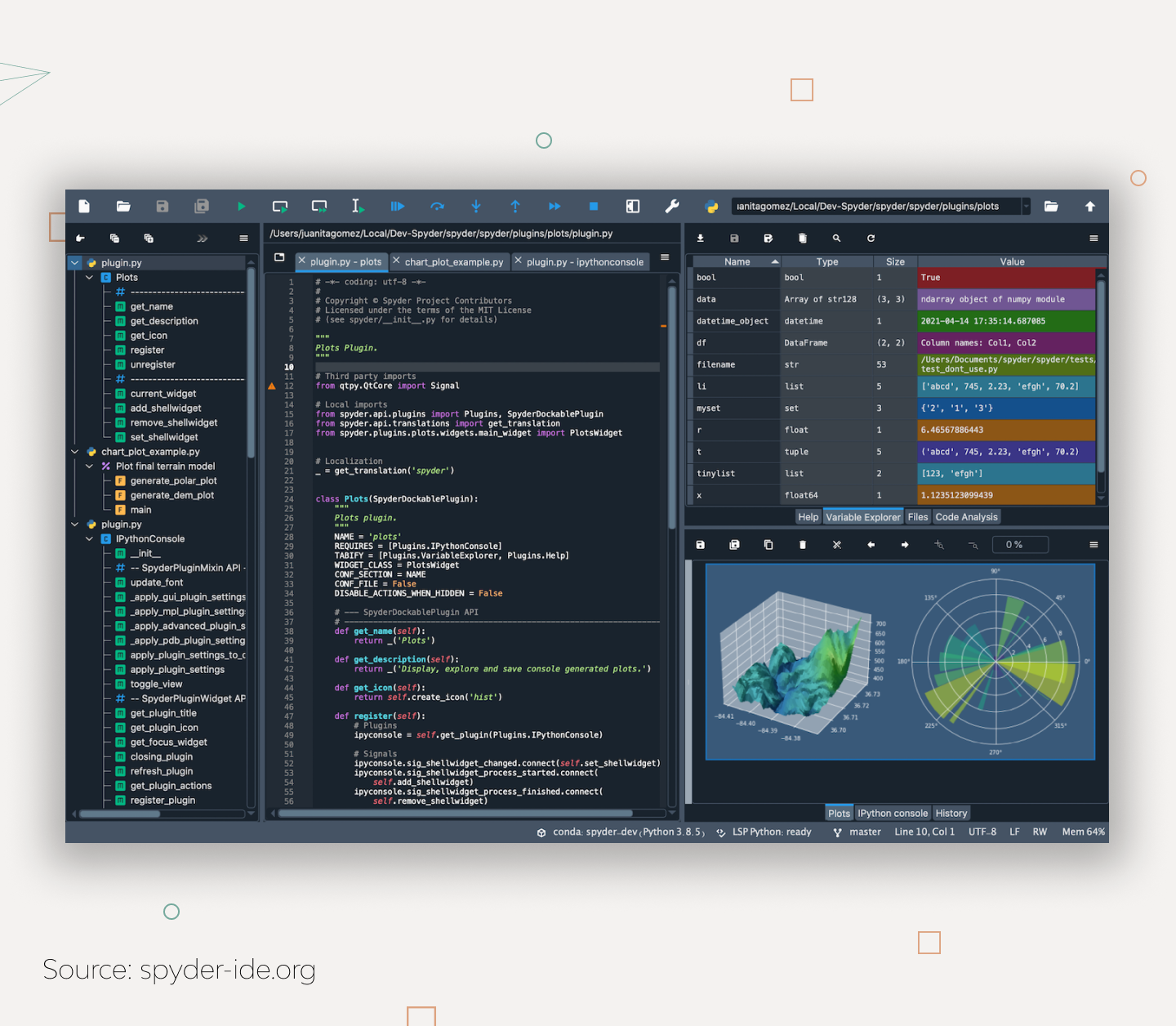
Spyder is created explicitly for data science. It’s open-source and compatible with numerous platforms making it a better choice for beginner IDE users. It merges its key libraries – like NumPy, Matplotlib, and SciPy – for perfect development.
JuPyter/IPython Notebook
Download link
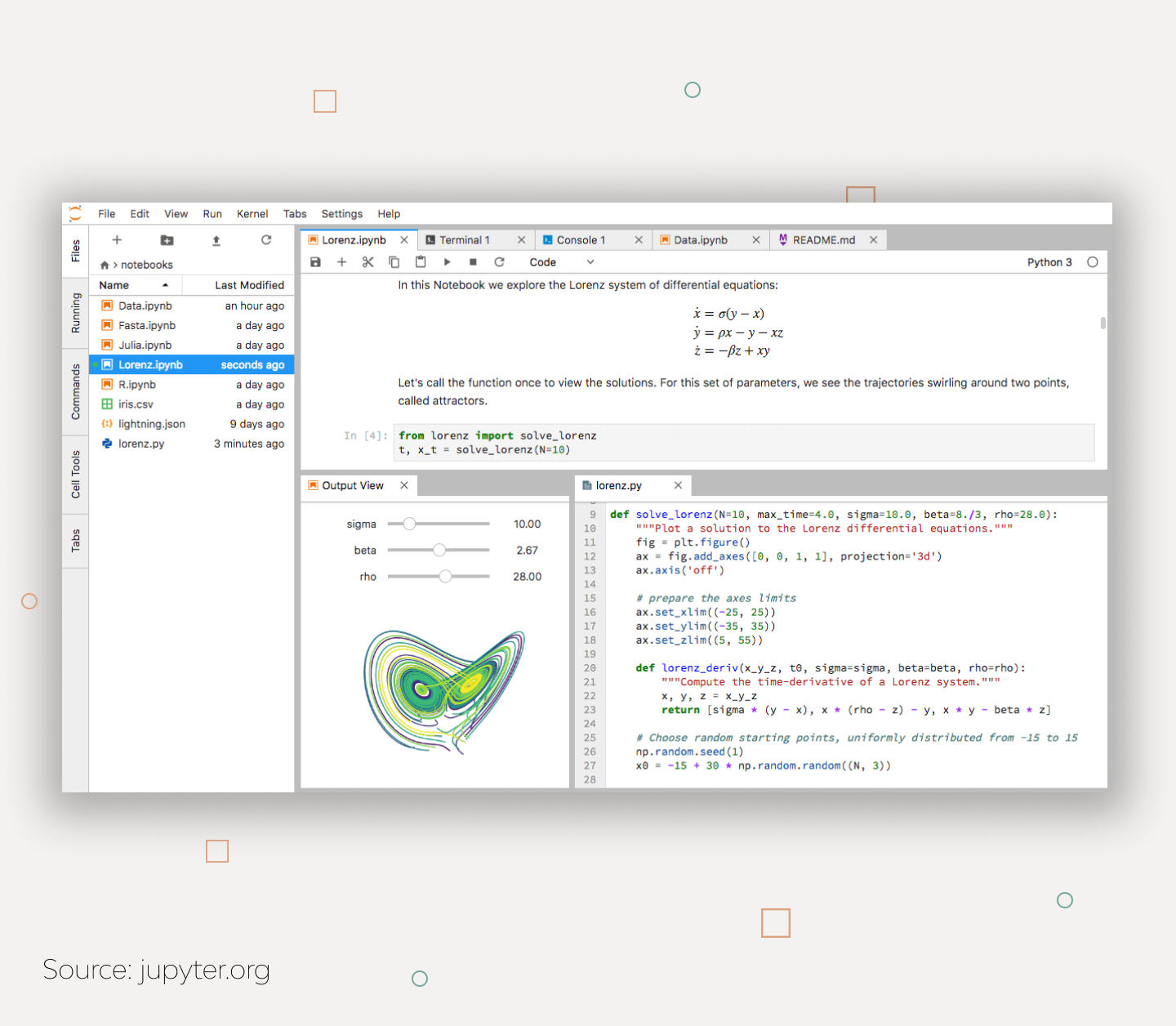
Jupyter is web-based and enables developers to build and operate scripts or notebooks. It is relatively simpler and more user-friendly. Jupyter also uses Seaborn and Matplotlib for data visualization.
Other Popular IDEs for Python Development
Here are a few more IDEs that are less known or less popular, but are still worth considering.
Atom
Download link

Atom is an open-source editor that’s compatible with virtually every programming language like PHP, Java, etc. It is regularly updated, reliable, and can be used universally. Github built Atom with powerful features that offer a good programming experience, including plugins, such as Packages — for SQL queries, Markdown Preview Plus — for editing, visualizing, and rendering LaTeX expressions.
IntelliJ IDEA
Download link

A well-known IDE from JetBrains mostly used by Java developers. It supports Python syntax highlighting, some basic features, and frameworks with plugin. It also supports other languages with plugins. It’s okay to use IntelliJ IDEA for Python, if it’s your second language and you need to edit some scripts from time to time. But if Python is your daily driver, I recommend to use PyCharm – it’s also developed by JetBrains and has a similar interface and feature set but focused directly on Python.
Notepad++
Download link

A very popular code editor for Windows. It supports a lot of languages including Python, Java, C, C++, C#, JavaScript, Ruby, PHP, etc. It’s a good “Swiss army knife” for multiple purposes, but like all multi-tools, it slightly loses a game to an instrument designed for a specific action. If you need to deal with different languages and you work only on Windows platform, then Notepad++ could be a good choice. But if your goal is specifically Python, we recommend to choose one of the tools from sections above.
When choosing the best IDE for Python programming, you should pay attention to these too.
Which Python IDE is Right for You?
Now that you know what to look for in a Python development environment, let’s pinpoint what to take into account to choose the best one in this short checklist. Consider these questions:
- Platforms. Does this Python editor support the version of the language and the platform you use?
- Updatings. Does it get updated? If so, are the updates frequent enough?
- Features. Does it have the complete feature set that is necessary for your work?
- Plugins. If some of the expected features are missing in the python code editor you prefer, can plugins cover for them?
- Payments. Do you have to pay for the license? Make sure if you or your company are willing to pay for it. It’s also important to find out if you will have to pay for the newer versions of this IDE in the future — it is a practice in single-payment-based products.
- Trials. Did you try working with it? Most subscription or payment-based editors have a trial period, so you can find your way around it and make up your mind.
Conclusion
We have reviewed a rich collection of the best Python IDEs and other tools. Deciding on which tool to use is a matter of convenience and one’s proficiency level. Of course, some IDEs, like PyCharm, stay in favorites due to features that are hard to find a replacement, but you can always try out a few other tools and see which ones work best for you. For instance, if you’re a beginner, consider starting with Sublime or VS Code. If a project has some additional specifics, such as scientific research with many graphs, Jupiter may be more convenient.
Some IDEs are better for beginners, while others are more professional; each of them has its unique features and design. We’ve put together this list to give you a variety to choose from.
Would you like to use the services of a professional Python developers team with over 120 projects under their belts? Give a boost to your project by contacting Django Stars.
- Why is using IDE for Django important?
- An IDE (Integrated Development Environment) helps to maximize a programmer’s productivity by incorporating closely related components with simple user interfaces. There is no better way to build in Python and Django than by using an IDE. It not only makes your work much easier as well as more logical; it also enhances the coding experience and efficiency.
- What disadvantages of using Python IDE exist?
- It's hard to write programs on a professional level without an IDE. However, to make your work effective, you should choose the tools that best suit your needs and capabilities. Certain IDEs may have their shortcomings, such as an overcomplicated interface, lack of required modules/plugins/templates, or limited free versions.
- Which Django IDE would you not recommend as a Python expert?
- There is no one-size-fits-all IDE. The choice of an IDE may depend on the developer's background and preference or the project needs. Some IDEs have features that beginners don't need, like PyCharm, or an unusual interface, like Vim. On the other hand, the features of simple IDEs, such as IDLE that comes with Python, may not satisfy experienced developers.
- Can you additionally advise me on the use of Python IDE?
Consider the following:
- Platforms supported
- Updatings (and their frequency)
- Features that are necessary for your work
- Plugins
- Payments
- Trial versions


